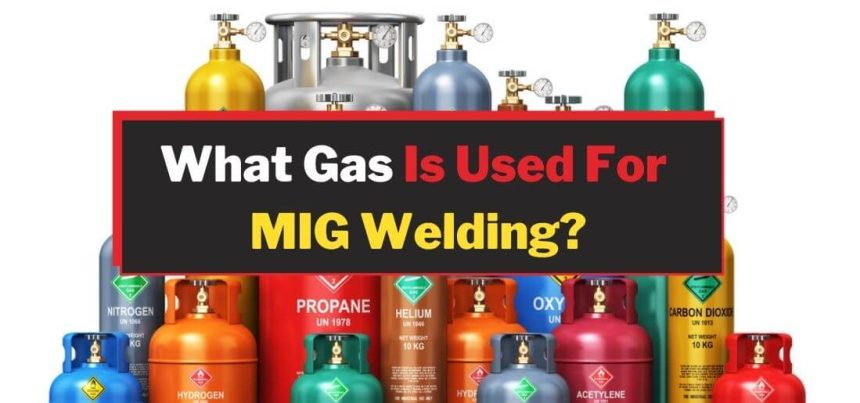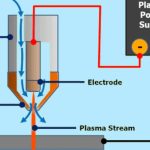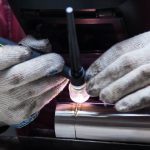An electric arc is used to fuse metals in MIG welding. Although it is utilized in many other sectors, the automobile sector uses it most often. This essay will discuss the many fuel types used for MIG welders and how they affect you. What kind of gas is used for MIG welding, and what are the main variations?
An electric arc is used to fuse metals in MIG welding. Although it is utilized in many other sectors, the automobile sector uses it most often.
021208.com
You are free to ask these queries. And to guarantee that the welding process is effective, you would want to know which gas is best before you start. Mig welding gas provides several advantages. Choosing the appropriate MIG welding gas to do the work is so crucial.
History of the Mig Welding Process
MIG welding is an established technique. It was created with metalworking but has since been modified for use in various circumstances. Steel and other metals are often created via MIG welding by a mig welder in discount welds. It may also be used to connect two metal objects. There are several types of MIG welding rods. The gas-shielded arc welder is the most used kind. This kind of welder joins metal components using an electric arc. The MIG welding method is trustworthy. It aids in fastening metal objects and connecting various metal kinds.
What gas is used for Mig Welding?
The optimum gases for Mig welding are a topic of discussion. However, MIG and TIG are the most often used options. MIG welding is ideal for fragile materials like aluminum because it uses less gas pressure than TIG welding. TIG welding, on the other hand, is more often used with heavier metals like steel. It depends on the characteristics you’re searching for in welding using the MIG welder wire process since both gases have advantages and disadvantages.
How much gas do you need?
A standard and secure method for joining metal is MIG welding. In MIG welding, the two pieces of metal are heated using a welder’s flame until they fuse. The kind of gas for a MIG welder may significantly impact the weld’s quality.
Three types of gas are used in MIG welding: air, argon, and helium. Each has its advantages and disadvantages.
Air is the cheapest welder MIG gas option and is the most common. It’s easy to find and doesn’t cause distortion or heat buildup near the joint. However, the air has low arc stability, so it can quickly form cracks in the weld when Welding at high temperatures.
Argon is a more expensive gas option but offers some advantages over the air. Argon is reliable at high temperatures, so you can weld thicker metals without losing strength. Argon also has good arc stability, meaning it doesn’t crack as easily as air. Helium is the most expensive gas option, but it offers the most benefits regarding weld quality.
Alternative Gases for Mig Welding
Alternative gases for MIG welding are often used in place of standard gas. They offer a variety of benefits, including reducing the heat and MIG wire required to weld, which can lead to faster and easier repairs.
The most common alternative gases for MIG welding are CO2 and argon.
In most cases, CO2 is utilized instead of air for MIG welding. It is less frequent than argon and more aggressive, although it also has certain benefits. One reason is that CO2 may be utilized more significantly since it is less costly than argon. Furthermore, CO2 may be utilized to weld metals that are more difficult to access with air since it has a more excellent melting point than air.
Argon is used in place of argon because it offers some additional benefits. Argon is more inert than argon, meaning it doesn’t react with other elements in the atmosphere and doesn’t produce toxic by-products when burned. It makes it a good choice for welding with high-quality steel or other materials that may be sensitive to other gases. Argon also has a low melting point so that it can be used to weld difficult-to-reach metals.
What Should Be The Accurate Gas Pressure For MIG Welding?
021208.com
Different ways to measure gas pressure
When welding with gas, the potential for a dangerous spark is always a concern. That’s why it’s important to use the right gas pressure for the task. Different welders will require different pressures to produce a clean, strong weld. To ensure you’re using the right gas pressure, you can use several methods to measure it. You can use a gauge to measure how much air pressure is required to create the desired arc. You can also use an airless welder MIG to determine the gas flow rate and then use that information to calculate the correct gas pressure.
Another way to measure gas pressure is with a meter that senses the voltage across an ohmmeter or red light-emitting diode (LED) probe when current is applied. This method is usually used in direct contact with the welding electrode. If using a MIG weld, consult your owner’s manual or ask your welding supply stores for more information on measuring the appropriate gas pressure.
Which Mig Gas is Best for Mig Welding?
A common technique for joining metal is gas-MIG welding. MIG welding may be done with various gases, but which is the best? TIG, MIG, and TFA are the three primary gases used for MIG welding. Everyone has benefits and drawbacks. The most frequent gas used for MIG welding is TIG (inert tungsten gas). It is appropriate for welding with medium to heavy thicknesses and has a high penetration rate.
Inert manganese gas, a less popular gas, is utilized for MIG welding. It is preferable for welds needing a greater degree of fusion or thinner thicknesses than TIG because of its lower penetration rate. TFB (tetrafluoroborate) is a novel type of gas gaining popularity among the best MIG welder. Unlike other gases, TFB doesn’t have an odor or produce sparks when it burns. It makes it ideal for use in enclosed spaces or difficult-to-reach places.
How to choose the suitable gas for your job
Popular methods for putting metal parts together include MIG welding. The kind of gas utilized may significantly impact the weld’s quality. Following are some suggestions for selecting the right gas for your job:
Argon has a low vapor pressure and is non-toxic, making it an ideal option for welding light or low alloy metals. Additionally, it is harmless and noncorrosive to both persons and welding supplies.
It is often required to use gas with more significant vapor pressure, such as helium or carbon dioxide, when welding high-alloy or challenging-to-weld metals to avoid moisture accumulating on the weld. These gases are more expensive, but since they generate so little heat, they produce better welds.
Proper Use of Gas for Mig Welding
A welder’s flame from a mig welding machine melts the metal together during the standard MIG welding technique. Several different welders’ torches may be used, each requiring a certain kind of gas. Propane is the most typical gas used for MIG Welding Guns. Propane is a widely used, readily available, and reasonably priced fuel that resembles gasoline. It has a low heat index, which results in a smooth, uniform weld and minimal heat distortion.
But other gases than propane may be used for the mig welding gun. Butane, natural gas, and acetylene are examples of more kinds of gases. Acetylene is a somewhat uncommon gas often only employed in highly specialized applications. Butane and natural gas are reasonably prevalent gases with benefits and drawbacks compared to propane.
The advantages of butane over propane are its affordability and ease of availability. However, since it is more prone to leaks and combustion problems than propane, it also has the drawback of being less dependable. Since natural gas doesn’t emit emissions when used, it offers the benefit of being ecologically benign.
Safety precautions for MIG welding with gas
Safety measures must be taken for welding jackets during MIG welding with gas and welder machine MIG to prevent injury.
Using common sense is the most crucial thing to remember while welding with MIG welder gas and mig gun. Make sure any possible trip risks are sufficiently removed from your workstation, and always be aware of your surroundings.
Utilizing the proper shielding material is another consideration while MIG welding with gas. Make sure the shield you use fits snugly around your welding torch and is suitable for the gas you’re using.
Finally, while MIG welding with gas and MIG welding wire, always wear appropriate safety equipment, such as a face shield, gloves, and a welders helmet.
Difference between Flux Core and Stick Welding
Given the variety of welding gases available for welding tables, MIG welder, choosing the right one is essential. The distinctions between stick welding and flux core welding will be covered in this article and are appropriate for a given job.
Flux Core Welding
To produce a weld, metal filler rods and flux materials are necessary for flux core welding. Fluxes are substances that help joints develop and the adherence of metal to the workpiece. The weld is deposited using the metal filler rod, which may be put in front of or behind the workpiece.
One of the primary benefits of flux core welding is its speed. Given that all of the heat is generated in the weld’s core, it may be finished quickly. As a result, flux core welding is perfect for high-speed applications like the manufacture of vehicles or aircraft. Flux core welding also has the benefit of applying to different metals. Since fluxes are not specific to any one kind of metal, they may be used on most metal types without any issues. Flux core welding is thus perfect for activities requiring you.
Pro Tips for Mig Welder
There are MIG welding tips to remember when welding with MIG welders. The type of gas you use is one of them.
Mig welders use a variety of gases. Therefore it’s crucial to choose the best one for the project. For instance, stick welding needs argon gas, whereas arc welding with a MIG welder requires a helium-neon mixture. The wire you use impacts the gas for MIG welding you choose. Acolyte wire is used for stick welding, whereas tin-plated wire works better for MIG welding with an argon/helium mixture.
The shielding gas is another factor to take into account. Shield gas is placed between the workpiece and weld to prevent a spatter. Nitrogen and carbon dioxide (CO2) are two popular options (N2).
Finally, make sure your gas MIG welder is appropriately maintained and configured. Use the right filler rod size, electrode type, voltage, amperage, and torch speed for the job. And keep an eye out for problems like misaligned electrodes or clogged or dirty MIG welders.
Conclusion
A common technique for joining metal components is MIG welding. Although various gases may be used for good MIG weld, argon is the most popular. For MIG welding, argon is the best gas to use since it is inert and does not react with the other components of the weld. The usage of hydrogen, helium, and nitrogen are additional gases that may be utilized for MIG welding.











